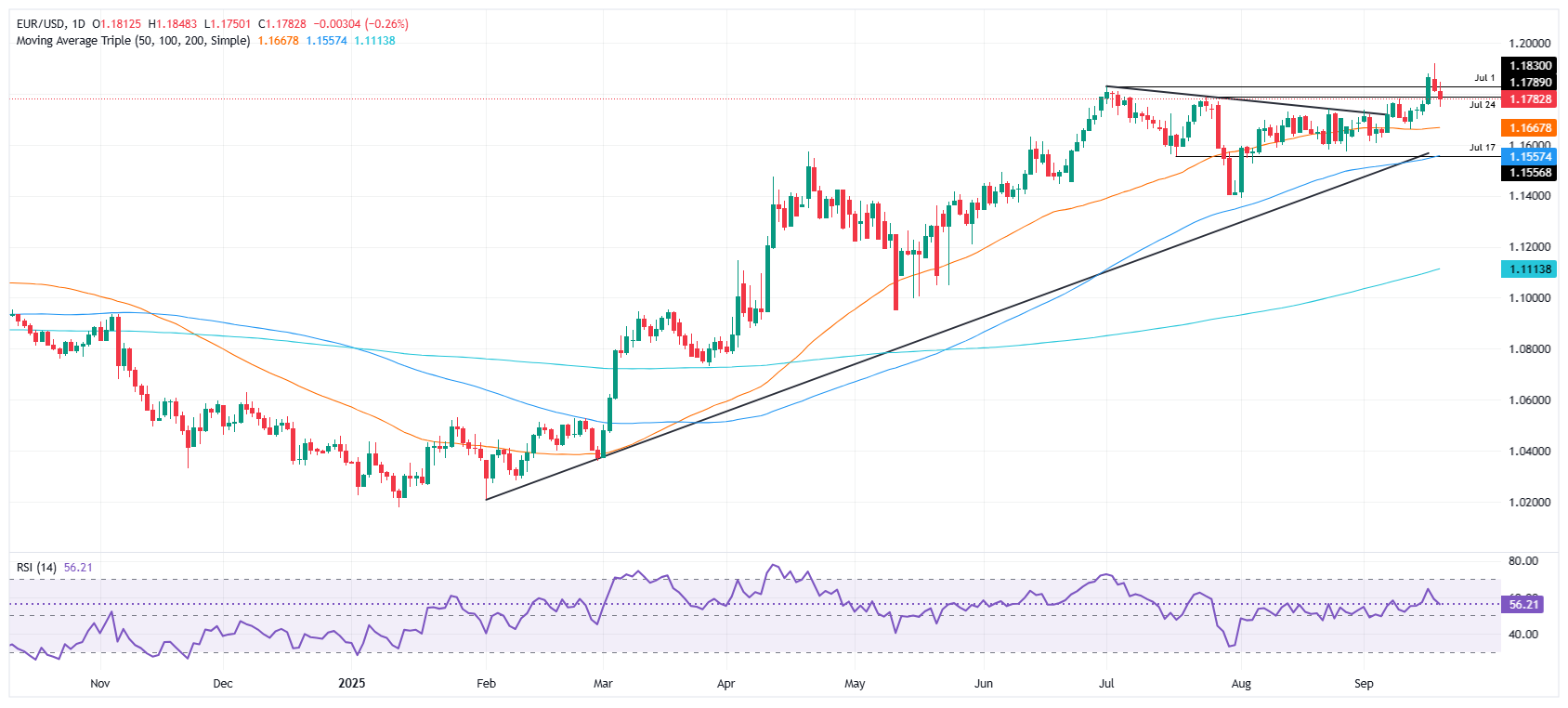EUR/USD falls to 1.1780 as Powell’s hawkish tone lifts US Dollar
- Euro retreats as Powell signals cautious stance despite 25 bps Fed cut.
- US Jobless Claims dip and Philly Fed survey beats forecasts, reinforcing Dollar strength in post-FOMC trading.
- ECB officials strike a neutral tone, saying rates are appropriate, with balanced inflation risks but weaker growth outlook.
EUR/USD retreats after reaching a yearly high above 1.1900 and falls 0.22% on Thursday, as goodish economic data from the United States (US) and a hawkish perception of Federal Reserve (Fed) Chair Jerome Powell boosted the US Dollar. The pair trades at around 1.1780 after hitting a daily high of 1.1848.
EUR/USD slips 0.22% after upbeat US data and Fed chair remarks temper rate-cut optimism
During the North American session, jobs data revealed that the number of Americans filing for unemployment benefits dipped, compared to estimates and an upwardly revised print for the previous week. The Philadelphia Fed Manufacturing Index posted outstanding figures in September, a sign of an improvement for the economy of the region.
US data was positive, but the EUR/USD downtrend began in the aftermath of the Fed’s decision on Wednesday. The US central bank cut rates by 25 bps, which sent the pair to its yearly high of 1.1918. Nevertheless, during Fed Chair Powell's press conference, it seems that sellers outweighed buyers, or the latter booked profits.
Powell acknowledged that labor demand softened and, despite inflation remaining “somewhat elevated,” noted that the balance of risks has shifted. He said that there was “no widespread support for a 50-basis-point cut today,” and stressed that the Fed is not in a rush to ease policy.
Across the pond, European Central Bank (ECB) policymakers led by De Guindos, Stournaras and Escriva stressed policy flexibility and a neutral stance. They see current rates as appropriate, with inflation risks balanced, but growth risks skewed to the downside.
Daily market movers: EUR/USD slumps as Dollar gains despite Fed rate cut
- US Initial Jobless Claims fell to 231K in the week ending September 13, undershooting expectations of 240K and down sharply from the prior week’s upwardly revised 264K. Continuing Claims also slipped to 1.920 million from 1.939 million.
- Meanwhile, the Philadelphia Fed Manufacturing Index rebounded strongly in September, jumping to 23.2 from August’s -0.3, far surpassing the 2.3 forecast and signaling robust activity in the sector.
- The Federal Reserve acknowledged growing downside risks to the labor market, noting that while unemployment remains low, it has edged higher. The policy decision was not unanimous, with Governor Stephen Miran opting for a larger 50-basis-point cut in line with some analysts’ expectations.
- The Summary of Economic Projections (SEP) pointed to an additional 50 bps of rate cuts anticipated by year-end, ending at 3.6%. Officials revised growth with GDP expected at 1.6%, up from 1.4%, while the Unemployment Rate was unchanged at 4.5%.
- Policymakers expect PCE inflation at 3% in 2025, with core figures projected to end at 3.1%, unchanged from the previous projections.
- The US Dollar Index (DXY), which tracks the buck’s performance against a basket of six currencies, is up 0.39% at 97.39.
Technical outlook: EUR/USD pulls back below 1.1800, bias stays bullish
EUR/USD retreats, but it remains bullish biased, although it is forming an 'evening star pattern.” Even though that is a bearish candle pattern, bears must clear the September 11 low of 1.1659. If surpassed, up next lies the confluence of the 100-day SMA and August’s 27 swing low at around 1.1560/74.
The Relative Strength Index (RSI) supports further upside, staying below overbought territory.
Conversely, if EUR/USD rallies back above 1.1800, expect further gains above 1.1850 to challenge the YTD high of 1.1918.

Euro FAQs
The Euro is the currency for the 19 European Union countries that belong to the Eurozone. It is the second most heavily traded currency in the world behind the US Dollar. In 2022, it accounted for 31% of all foreign exchange transactions, with an average daily turnover of over $2.2 trillion a day. EUR/USD is the most heavily traded currency pair in the world, accounting for an estimated 30% off all transactions, followed by EUR/JPY (4%), EUR/GBP (3%) and EUR/AUD (2%).
The European Central Bank (ECB) in Frankfurt, Germany, is the reserve bank for the Eurozone. The ECB sets interest rates and manages monetary policy. The ECB’s primary mandate is to maintain price stability, which means either controlling inflation or stimulating growth. Its primary tool is the raising or lowering of interest rates. Relatively high interest rates – or the expectation of higher rates – will usually benefit the Euro and vice versa. The ECB Governing Council makes monetary policy decisions at meetings held eight times a year. Decisions are made by heads of the Eurozone national banks and six permanent members, including the President of the ECB, Christine Lagarde.
Eurozone inflation data, measured by the Harmonized Index of Consumer Prices (HICP), is an important econometric for the Euro. If inflation rises more than expected, especially if above the ECB’s 2% target, it obliges the ECB to raise interest rates to bring it back under control. Relatively high interest rates compared to its counterparts will usually benefit the Euro, as it makes the region more attractive as a place for global investors to park their money.
Data releases gauge the health of the economy and can impact on the Euro. Indicators such as GDP, Manufacturing and Services PMIs, employment, and consumer sentiment surveys can all influence the direction of the single currency. A strong economy is good for the Euro. Not only does it attract more foreign investment but it may encourage the ECB to put up interest rates, which will directly strengthen the Euro. Otherwise, if economic data is weak, the Euro is likely to fall. Economic data for the four largest economies in the euro area (Germany, France, Italy and Spain) are especially significant, as they account for 75% of the Eurozone’s economy.
Another significant data release for the Euro is the Trade Balance. This indicator measures the difference between what a country earns from its exports and what it spends on imports over a given period. If a country produces highly sought after exports then its currency will gain in value purely from the extra demand created from foreign buyers seeking to purchase these goods. Therefore, a positive net Trade Balance strengthens a currency and vice versa for a negative balance.

